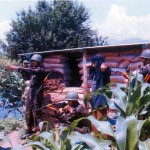
The Navy’s Regulations on the subject of moustaches and beards had adopted, verbatim, the regulations of the British Navy. These required that a naval officer or sailor:-
-
- had either to have both beard and moustache or neither.
- had to obtain the approval of his Commanding Officer to “discontinue shaving” or to “continue shaving”.
As in the case of smartness of uniform, the spirit of these regulations was to ensure that control could be exercised on the tidiness of facial appearance so that personnel did not bring discredit to the Navy by looking untidy.
In 1970 and 1971, the Navy began to be exposed to several influences:
-
- One of them was the American Navy. As a result of lack of enthusiasm for the Vietnam War, the American Navy allowed relaxations in dress and personal appearance which, they considered, were acting as a disincentive to service in Vietnam.
- The fashions prevalent in America at the time were long sideburns, moustaches with or without beards, flared trousers etc. These fashions were being imitated by Indian youth in the ports where naval ships were based. The Navy’s youngsters found themselves being considered as oddities by their civilian peer group. Pressures began to grow to relax the Navy’s regulations.
- In mid 1970, the tendency of sailors’ to resort to agitation manifested in the Topass incident. This triggered widespread demands for change, the response to which was a series of welfare measures to help cool things down.
- Last, but not the least, was a genuine Indian problem. In India, since time immemorial, the moustache has been a sign of manhood and valour. Many sailors, well before going on leave, sought permission to ‘discontinue shaving’, so that by the time they reached their homes, they could sport a moustache. On return from leave, they would seek permission to ‘continue shaving’. The irksomeness of this procedure found expression after the Topass incident.
Admiral Nanda was the CNS from 1970 to 1973. He recalls:
“One day I was having a cup of tea with the sailors. A Rajasthani sailor came up to me and said, “Sir, it is a great hardship that beards and a moustache must go together. When I go home, if I don’t have moustaches, people ask me “Is your father dead?” Because the tradition in Rajasthan is that if you shave off your moustaches, it is a sign that your father has died and you are in mourning. It is also a tradition that to show your manliness, you have to have a moustache. Therefore to go home, I have to request to grow a beard and only then can I grow moustaches also. Then we cannot go out from the ship on liberty until the beard has grown. The day my leave starts, the first thing I do is to go to a barber and shave off my beard so that I can go home with a moustache and show that I am a man. The day I have to come back to duty, I have to go to a barber again and tell him to shave my moustache now, because I have got to go to duty and without a beard I cannot have a moustache. So, sir, this is a great hardship. I come to the ship, without a beard, without a moustache and then I have to start growing beard and moustache again two months before I start my next leave.” Things like this started me thinking as to what is the validity of the naval tradition we adopted from the British Navy. Should this be pushed down the throats of people who don’t like it, who are not with it?”
In early 1971 the regulations were amended to read:
“The following provisions shall govern wearing of moustaches and beards:
-
- The Captain may permit officers and men to wear moustaches and beards or shave them off, if they so desire. Moustaches and beard shall be worn with or without the beard and moustaches respectively. Side whiskers shall be permitted down to the level of the lobe of the ear. The privilege may be withdrawn in cases of untidy growth.
- Moustaches, beard and whiskers shall be neatly cut and trimmed”.
Changes in Uniforms 1965 to 1975
The same pressures for relaxation which led to changes in the regulations for moustaches and beards also led to changes in uniforms, “to bring outdated traditional British uniforms in line with modern trends”.




